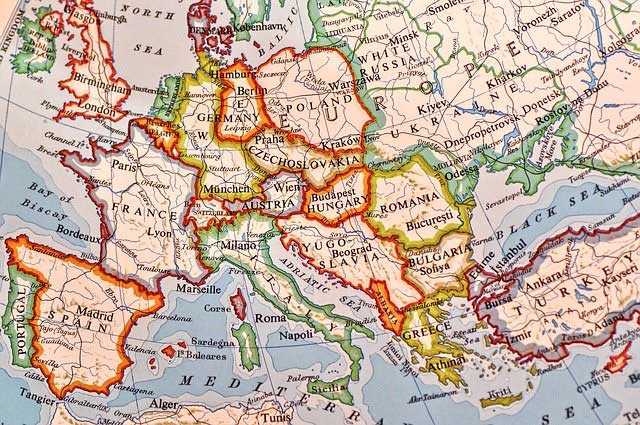Welcome to this post about patents and chips. Not a lot has been written about this combination, but there is a lot to know, especially for the innovators and entrepreneurs themselves. In this three-weekly series, I talk about various aspects, from a dual perspective of a patent agent and a semiconductor entrepreneur. If you like the article and read it on LinkedIn, give it a thumbs up, and/or click on Follow. If you like to work with us for your next patent, "contact us" info is on www.icswpatent.com. You can also subscribe/unsubscribe for short email alerts when the next post is available.
Europe has been a scattered place historically, but over the past seventy years it's been pulling together quite a bit. For patents, that showed only partially. A European Patent (EP) can be applied for and prosecuted (defended) in one place, which is very cost effective. However, once it has been granted, it must be validated and maintained (yearly payments) in individual countries that you select immediately upon grant. It can be challenged and enforced only in those selected countries. The reach of the EP is very good. With 38 countries it goes well beyond the 27 countries of the European Union (EU). It even includes Morocco and Tunisia. But the cost of maintaining a patent in all 38 countries is very high.
EU countries have long pursued something similar to the US system, where you have one application, that results in one patent that is valid for the whole block. After decades of negotiations, 2022 will be the year it starts, even if only partially meeting this goal. Of the 27 EU countries, 25 have signed the unitary patent (UP) agreement, and 17 of those have now ratified it. The two non-participating EU states are Spain and Croatia. Additionally, the 11 non-EU states that can't participate include the UK (thanks to Brexit), Switzerland, and Turkey.

|
17 Current UP Countries |
For most companies, the cost is a huge consideration when planning patents. A good part of the cost is in renewal fees (called maintenance fees in the US). The traditional EP can get very expensive if you want to be covered in all 38 states. If you'd want coverage in only the current 17 states that offer the UP, then the UP is much less expensive than the traditional EP. But renewal fees of the UP are still about 3 times as expensive as for a US patent (about €35k versus about US$13k). However, if you count only the first 15 years, then the accumulated fees are slightly less than for maintaining a US patent. Should you want coverage in fewer than 4 states and your cost horizon is more than 15 years, then validating the traditional EP in individual countries provides the best option from a fees' perspective.
Lost it?
OK, let's look at the diagram. It assumes you know what countries you want to cover with your patent.
 We'll take a shortcut first, because we know you have a semiconductor business. Say you're a startup that wants to protect its core technology, and you plan to strike it rich within 2 eternities (i.e., 10 years). You'll take a UP patent plus UK. Here's how you come to that conclusion, using the flow chart on the left:
We'll take a shortcut first, because we know you have a semiconductor business. Say you're a startup that wants to protect its core technology, and you plan to strike it rich within 2 eternities (i.e., 10 years). You'll take a UP patent plus UK. Here's how you come to that conclusion, using the flow chart on the left:
First, you're going to ask if you want coverage in all EU states. You don't know, because you're not rich yet. Can you afford it? Maybe not yet. You answer no, and look at the next consideration. Do you need coverage in less than 4 countries? Well, it's your core technology, but you don't have much money. Maybe you can pick just the big ones, Germany and France. But you plan to strike it rich within 10 years, well within the 15 years cost horizon condition. So, the answer is no, and you’re going to get a Unitary Patent. You go on to the next question, do you need coverage in any non-UP countries. Yes, you want the UK, so you add an individual national-stage EP for the UK. If not for that bloody Brexit, it would have been included for free. Aaarrggh! Anyway, you're done.
In another scenario, you need to patent something that is not core technology. It's a nice feature to have. You also want to stay independent for the long term, so you look at the full 20 years for your cost horizon. Those last ones are the most expensive for a UP. So you compromise: not all EU states (only Germany and France). That it less than 4 countries, and you look at the long-term cost, so you're not getting a UP, but you're getting individual national EPs for Germany and France. In the next step, you add UK as the third country that is important to you, and you get a national-stage EP there, too.
The above assumes you know what coverage you want. But how do you determine that? Chip companies weighing their patenting priorities often use GDP as a measure, or chip design activity. Looking at the GDP of European countries (EU and non-EU), the 2021 top-8 rounds out as Germany, UK, France, Italy, Russia, Spain, Netherlands, and Switzerland. This year (2022), Russia bombed itself out of this list, so that leaves seven. This includes four UP countries (Germany, France, Italy, and Netherlands) and three non-UP countries (UK, Spain, and Switzerland). You may prioritize from this list, or modify it a bit if you also want to consider IC design activity: Germany, UK, France, Netherlands, Italy, Switzerland, Belgium, Sweden, and Finland, with the order varying based on which particular IC market you consider.
If your chip company is up to 20 people, your patent budget is going to be limited. You'll already prioritize the US, China, Taiwan, and Korea, and not funding them all. If you do anything in Europe, it will probably be Germany, the UK, and France. But, considering the above labyrinth – for core technology you might take the UP anyway, and add the UK.
If you're a little bit larger, then the UP is attractive, and you might add the UK, and maybe Switzerland, and Turkey. So, how do you "add" those countries?
|
25 Eventual UP Countries |
 While avoiding the rather boring details of the mechanics of obtaining patents in Europe, a basic flow can be:
While avoiding the rather boring details of the mechanics of obtaining patents in Europe, a basic flow can be:
- Wherever you are in the world, you might file a patent application there, or somewhere else (for example, the US), or you might file an international patent application (better known as PCT application)
- Within 12 months (for a non-EP priority application, e.g., in the US) or 31 months (PCT) from your original filing date, you file a European patent (EP) application
- You prosecute the EP (your patent firm responds to office actions of the European patent office) until the patent is allowed
- Within one month of grant (i.e., one month after the date of publication of the mention of the grant in the European Patent Bulletin), you apply for unitary status to get a unitary patent
- And also, you "validate" (i.e., register) the patent in additional states where you want traditional EP coverage, e.g., the UK
If your company is big, with large patent budgets to throw around, you may follow other flows and have all kinds of other considerations. For example, a unitary patent can only be challenged in the Unified Patent Court (UPC), whereas the traditional EP has to be challenged in the courts of every country where it was validated. There are some interesting consequences involved with a UP providing patent protection in all participating countries. For example, the cost of litigation of a UP is likely higher than the cost of litigation of a national patent, and if the UP would be invalidated, it is invalidated in all participating countries. However, if the UP prevails and infringement is determined, a UP will most likely be awarded much higher damages and compensations than a national patent. Therefore, the strategic considerations weighing the pros and cons may be more important than simply basing the decision of going for a UP or a national patent on cost.
In conclusion: the UP and the UPC are big steps in the right direction. However, a UP is not for everyone, and you need to consider your company's individual requirements.


